Hellfires were set loose in Helsinki, Finland last weekend by a horde of black metal maniacs from all over the Earth. Profanation, an intangible feeling of myth, alignment of spirits, pervaded the atmosphere. Let me remind you that while the gig situation concerning underground black and death metal in Finland is rich and fertile, every so-called cult band appearing on stage is no longer going to change anyone’s life to something more mysterious and powerful. Maybe the younger audience sees the matter differently, but I believe they are becoming jaded also. This weekend was something different however. The main event was the 2-day Black Flames of Blasphemy fest, on 23rd and 24th, the Friday night featuring Taake and Horna, among others, but I wasn’t attending, on one hand because of a lack of interest regarding the bands, on the other because I could use one spare night between the “pre-party” on 22th (aptly called “Unholy Night to Remember”) and the Saturday explosion featuring bands of the caliber of Blasphemy and Revenge from Canada.
The dark side of Finland
So, it all started on a rainy and windy Thursday night, in a small Helsinki pub called Darkside which I had only visited once before, when it was empty. No-one was expecting a large crowd because normal people would have jobs and studies to attend to, but the place was crowded and intense. Demonos of Barathrum, the drunken bastard, was shouting at the doorman and people were consuming beer like it was the eve of ragnarók. In that one room of a few hundred cubic meters had been compressed all the dreams and neuroses of Finnish black metal since its very beginning. Even Pete Helmkamp came around to see for himself what the fuck was going on. Ofdoom, a Blasphemy clone from Hamina whose members are barely 18 years old, played a reasonably aggressive set of uncannily familiar sounding songs. I am thankful that at least the cover song choice was “Christ’s Death” by Sarcofago instead of something from the war metal scene. Many of the old school maniacs I met applauded the energy and sincerity these young guys brought to the evening. However, I was more thrilled by the Goatmoon set that saw the audience become a rioting mass of fists and headbanging. The garage punks of Finnish black metal, Goatmoon unleashed a set of familiar songs from their albums mostly resembling a triumphantly melodic cross of Dimmu Borgir demos and Absurd, not to mention an enormously provocative cover from Finnish RAC band Mistreat.
But the real reason why everybody was there that night, the crux of all the anticipation and nervous violence was the return of the infamous Azazel on stage, an early Finnish black metal coven lost to annals of history but fondly remembered by everyone who breathed the air of 90′s Finland, when worship of darkness was still pure and cold… clad in spikes. Stories about Azazel and their infamous frontman Lord Satanachia are equivalent to an inverted saga, one of madness and devotion. For a decade the band was forgotten until suddenly it seemed to have reformed in alliance with some members from young occult metal band Charnel Winds. It all seemed unbelievable and to see it with one’s own eyes… triumph!
It wasn’t a surprise to anyone that an Azazel gig might prove to be a disaster, in normal sense. Enveloped in the mists and throes of an ancient curse, the guitarist’s malfunctioning equipment threw the disorganized band from the brink of a metaphorical cliff into the abyss, to be carried upon the wings of Death. While Demonos threw himself from the audience into the stage in an alcoholic spasm, wires were torn, microphones were ripped and fists started flying. Part of the equipment was mute, the rhythm section was confused and Satanachia’s croaks were barely audible chants and incantations of demonic names. A morbid pall descended upon Helsinki. In anti-arranged structures of primitive, broken black metal, Azazel mocked everything and everyone. Brilliant and beautiful riffs, performed at variable and confused speeds, interlocked with rhythms and blasts whose randomness remained cryptically problematic. No-one knew if the songs are actually like this or have all the members gone insane. The most sensitive part of the crowd was devastated and ultimately impressed. Others were bored and drunk. Enough said about that evening except that I doubted even Saturday can give a more authentic black metal experience, because for the rest of the night and the next day, Azazel’s psychosis was still deeply within my heart.
The church of blasphemy
Saturday night was again cloaked in the weather of Jack the Ripper’s London. Through the rain we approached the ominously titled Dante’s Highlight, converted from an old church on whose steps Mannerheim and Hitler had shaken hands in a pact of war. It served as a normal nightclub until a few years ago it became one of the prominent metal bars of Helsinki. We have no knowledge how much blasphemous intent influenced its current use, but it was something to see candles and torches lighting the altar (stage), bestowing a comforting, cavernous gleam upon the high ceiling and reflecting from the chain-wrapped wooden posts adorned with gasmasks. The gig organizers par excellence Kold Reso Kvlt had taken lots of care in making this event perfect, as it was also the destination of a veritable exodus of German, French, Italian and other foreign black and death metal fans.
Proclamation from Spain launched into formally perfect, yet somehow vague and heartless Blasphemy aping primitive death metallic sounds and while the gig was technically the dream of your standard NWN forum fan, it raised apprehension that this is going to be an evening where every band sounds the same and everyone plays a Blasphemy cover! There was still some space to move around the building but despite three floors, it was rapidly becoming claustrophobic and difficult to breathe. The gig had been sold out ages ago. Black Witchery from Florida, USA, specialized in repetitive high speed exercise of redundant riffs, which despite its great marketing value to black metal consumers lacks the spiritual depth and intellectual convolution of the high masters of the genre. To anyone who has heard a Black Witchery album or two it was easy to guess what the gig is all about and for their fans, they probably did deliver the goods. I liked a few of the atonal, destructive, confusional parts that reminded me of the greatness of the Australian disbanded legend Bestial Warlust.
By the time the third band, Archgoat from Turku, Finland, commenced their set, the full force of the Finnish metal scene had already coalesced upon the building and for anyone who knows people or is known himself, much time and attention had to be spent on greetings, handshakes, throwing the horns, mock fighting and the like. However, the atmosphere was also rapidly gaining a more intense, expectant and noxious odour. Screams, blood and bursts of madness spattered the overcrowded club. Between pockets of peace, chaos reigned, the passing of souls from one layer of Hell to another, brother and enemy united in prayers of profanation. While for some people the grinding, organic and physical malevolence of Archgoat marked their best gig ever, I say the 2005 comeback gig after a decade of silence still holds the scepter. Heavily influenced by VON and Sarcofago, Archgoat was the first band of the evening to capture a cold, theatrical melody and frame the counterpoints of primitive death metal riffs with heavy, well placed doom. It was the only performance of the evening whose spine was not hardened by monotonous speed. Instead, it slithered up the walls like a serpent of abomination.
Nature’s revenge
Amidst beer, guts and blood, headbanging Italians and Finns going mad over the controversies and abstractions of the night’s leading band (“Are Blasphemy real, do they really exist?” “Is that negro over there Caller of the Storms?”) everyone who was ever famous in Finnish black metal walked entranced amidst the crowd, as one with the spiritually dead. Black metal skinheads went out for a smoke and traded with kebab and banana merchants around the corner. Someone’s face was fisted and another got a kiss from a new girl.
Revenge, the Canadian commando force, was for some members of the audience the main event to witness here and for a good reason. By the unholy candles’ light, between the walls built to serve God, James Read attacked the drumkit like a voodoo priest releasing magick vapours of steaming ether, in a sharp and fluid tribute to grindcore percussion masters. In a battle position, in the attire of a right wing street fighter, Helmkamp’s fingers tore thrash influenced phrases from the trusty bass guitar as he used to do already decades ago in Order from Chaos, while his sharp intonation revealed the lyrics be less a narration, more a ritual chant of words whose meaning and connotation have been obvious to warriors for millennia: “traitor”, “victory”, “blood”, “conquest”, “force”, “survival”. The robotic, inhumanly precise ability of the three musicians to control chaos resulted in the most impressive technical display of the evening. It caused uncertainty and fear. What can even the mighty Blasphemy do after this 100-percent martial art display of perfect war metal kata forms?
Luckily we didn’t need to wait very long until Black Winds and co. gave us the answer. As a storm of the angels of apocalypse and doom, this noisy but influential group of Canadians were far from any kind of perfection in their music. They appeared as in constant battle, a crackling terror of violent audial force, ripping and rending the soundscape of world without end. Dramatic and physical, it seemed as if the walls are about to collapse. Black Winds seemed at times lost, at others frenzied and focused. Strong war screams arose from his throat in defiance to heavens. Caller of the Storms didn’t play his guitar, he molested its corpse. A gargantuan sized session bassist filled the forefront and provided background vocals. Ryan Förster of Conqueror played second guitar wearing a gasmask. Original drummer 3 Black Hearts of Damnation and Impurity pulsed, leaped and attacked with his beats as lightning that strikes amidst a raging storm. It wouldn’t be correct to say the band was in top form, or something. The band was a force of nature, a mission of war that happened on stage. It didn’t compete with the musical precision and finesse of Revenge. It maimed the listeners with its droning and anti-sacred frequencies into submission, obeisance and ultimately an intuitive sense of the laws of nature. Cosmos, life, nature is about war. That’s what war metal and Blasphemy is about. The order of things, as it is, revealed in chaos. The highest principle of art, which is truth. Rarely, in years of seeing the finest of the bands perform on stage, have I been filled with such a calm, inspired joy as in the midst of this night’s rendition of “War Command”.
http://www.youtube.com/watch?v=iik8gL-rey8&feature=results_main&playnext=1&list=PL36851714E96D445C
Thus, I have witnessed two of the finest evenings of black metal this year. I give my highest and sincere thanks to individuals who year after year, day after day, spend their attention and hard work to organize cultural events of the highest magnitude, even while they will never be as celebrated for their work as even mediocre bands are. Flyers and ads already promise interesting happenings for next year, so for now, I still very much enjoy living in this Northern land of bloody lakes and corpse-strewn woods!
2 CommentsTags: Black Metal, Canadian Death Metal, death metal, Death Metal Live Shows, Grindcore, Thrash, War Metal

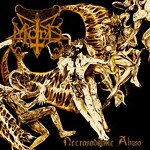 The new Osmose recruits Mord seem to have been actually born in Poland, then relocated to near Kristiansand, which is remembered as the location of a violent death metal sect in support of Varg Vikernes back in 1991 and the origin of Tchort (Blood Red Throne, Emperor, Green Carnation). Not quite living up to the bloody and progressive traditions of the area, Mord specializes in a cold, modern, thrashed-out black metal sound that could scientifically have been developed in a norsecore factory to create an endless amount of productive clones. Maybe because they are originally from Poland, they do seem to possess a better grasp of what makes Nordic black metal good than most Scandinavians around exhibit. They keep the album vile and to the point, imitating the blasphemous rhythm guitar of, besides Euronymous, Ivar Bjørnson during the phase of Enslaved when they dropped most of their classical influence and switched to riff rock. Later Ancient springs to mind in tracks such as “Opus II” which is essentially is a meeting of pop and black metal in a graveyard infested with drunked teenagers who wear makeup and like to flash stupid expressions in photos. It may sound bad but in fact, as guitar rock or something, it excels. It is simply lacking in the Romantic nature worship, warrior ideology and mysticism of Burzum, Ildjarn and the other greats. So while musically this has potential for an above average Norwegian black metal album (even though these ideas are 15 years late) it ends up as one more relic that brings black metal closer to mainstream acceptance and youth culture phenomena today, and no-one will remember it in ten years.
The new Osmose recruits Mord seem to have been actually born in Poland, then relocated to near Kristiansand, which is remembered as the location of a violent death metal sect in support of Varg Vikernes back in 1991 and the origin of Tchort (Blood Red Throne, Emperor, Green Carnation). Not quite living up to the bloody and progressive traditions of the area, Mord specializes in a cold, modern, thrashed-out black metal sound that could scientifically have been developed in a norsecore factory to create an endless amount of productive clones. Maybe because they are originally from Poland, they do seem to possess a better grasp of what makes Nordic black metal good than most Scandinavians around exhibit. They keep the album vile and to the point, imitating the blasphemous rhythm guitar of, besides Euronymous, Ivar Bjørnson during the phase of Enslaved when they dropped most of their classical influence and switched to riff rock. Later Ancient springs to mind in tracks such as “Opus II” which is essentially is a meeting of pop and black metal in a graveyard infested with drunked teenagers who wear makeup and like to flash stupid expressions in photos. It may sound bad but in fact, as guitar rock or something, it excels. It is simply lacking in the Romantic nature worship, warrior ideology and mysticism of Burzum, Ildjarn and the other greats. So while musically this has potential for an above average Norwegian black metal album (even though these ideas are 15 years late) it ends up as one more relic that brings black metal closer to mainstream acceptance and youth culture phenomena today, and no-one will remember it in ten years.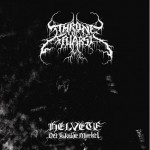 While the gloomy shroud of 21st century black metal clichés weighs like lead upon Throne of Katarsis, a sense of ambition and greatness, the carefully followed tread of frozen melody including an airy vastness copied from In the Nightside Eclipse or early Taake and some elegant and progressive forms makes this rise above the level of total weakness. Like Isvind and Tsjuder, Throne of Katarsis explore the melodic territory in between Darkthrone and Emperor in an effort to replicate the impression of transcendent evil boiling in the depths. Fast percussion underlies the sonic depression of dubiously plodding, soaring but monotone and unenergetic low production (Grieghallen copy) guitars repeating spherical themes (rotating the minor chords “De Mysteriis” style during the slow parts over and over again to give the melancholic feeling) over to vastness. The best of the musical ideas are hidden by the desire to create a standard black metal album, as they probably succumbed to creating an album too quickly and thinking that it’s enough to put out cold and intensity-devouring two-penny riffs that have been overused for 20 years – bulk Norwegian black metal in good and bad.
While the gloomy shroud of 21st century black metal clichés weighs like lead upon Throne of Katarsis, a sense of ambition and greatness, the carefully followed tread of frozen melody including an airy vastness copied from In the Nightside Eclipse or early Taake and some elegant and progressive forms makes this rise above the level of total weakness. Like Isvind and Tsjuder, Throne of Katarsis explore the melodic territory in between Darkthrone and Emperor in an effort to replicate the impression of transcendent evil boiling in the depths. Fast percussion underlies the sonic depression of dubiously plodding, soaring but monotone and unenergetic low production (Grieghallen copy) guitars repeating spherical themes (rotating the minor chords “De Mysteriis” style during the slow parts over and over again to give the melancholic feeling) over to vastness. The best of the musical ideas are hidden by the desire to create a standard black metal album, as they probably succumbed to creating an album too quickly and thinking that it’s enough to put out cold and intensity-devouring two-penny riffs that have been overused for 20 years – bulk Norwegian black metal in good and bad.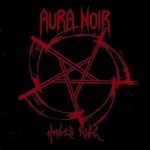 I do remember the Apollyon/Aggressor duo Aura Noir as a high-energy, motor powered and tradition respecting black metal cult from the days of the bewitching “Dreams Like Deserts” MCD, never afraid to rock out nor experiment with unusual guitar and drum techniques – even cross-quoting with Ved Buens Ende material. Something really devastating has happened and I don’t know if it has to do with Aggressor’s falling down from a balcony or something, but they sound totally drunk, tired and old on this album. I mean, if you think that Darkthrone nowadays sounds like a lazy beer-swilling band from the pub, try this one! I can hear they are trying to play like Sodom, but I can’t hear any Germanic “raaaaaah!” mania. I can hear Autopsy, but I can’t hear the stinking amputated corpses rising all around to wreak their vengeance upon the societies of the living. I can hear hardcore, but I can’t hear the decisive violent power of wrath against conformity. So, what is there left? It sounds a bit Southern Lord-y – you know, ironic old metal fan hipster who likes to get stoned out of his mind and listen to feel-good old-times metal. By the way, the drum production sounds like MIDI – utter failure. If you want real speed/black metal power, go for the originals, this one is a weak joke.
I do remember the Apollyon/Aggressor duo Aura Noir as a high-energy, motor powered and tradition respecting black metal cult from the days of the bewitching “Dreams Like Deserts” MCD, never afraid to rock out nor experiment with unusual guitar and drum techniques – even cross-quoting with Ved Buens Ende material. Something really devastating has happened and I don’t know if it has to do with Aggressor’s falling down from a balcony or something, but they sound totally drunk, tired and old on this album. I mean, if you think that Darkthrone nowadays sounds like a lazy beer-swilling band from the pub, try this one! I can hear they are trying to play like Sodom, but I can’t hear any Germanic “raaaaaah!” mania. I can hear Autopsy, but I can’t hear the stinking amputated corpses rising all around to wreak their vengeance upon the societies of the living. I can hear hardcore, but I can’t hear the decisive violent power of wrath against conformity. So, what is there left? It sounds a bit Southern Lord-y – you know, ironic old metal fan hipster who likes to get stoned out of his mind and listen to feel-good old-times metal. By the way, the drum production sounds like MIDI – utter failure. If you want real speed/black metal power, go for the originals, this one is a weak joke.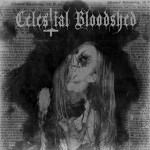 It would be quite interesting to see if someone, somewhere in Norway, has during the year released black metal or death metal which does not a) try to duplicate the old Grieghallen soundscape with in the most generic no-sense-of-style manner, b) fill their album with a load of budget riffs called depressive black metal by the kids (which is actually C, D, E minor again… and again…). Anyway, while Celestial Bloodshed has ripped off these ideas from better bands, they are 50% better in their songcraft than Watain, Funeral Mist and other generic black metal of the era. Also, they have been able to create inner beauty towards the realization of the music in melodic intensity. Additionally, the fullness of the soundscape and the implications of the structure make this release more grim, oppressive and grinding than the mainsteam manipulations of Norwegian metal which can not be but a good thing. After a beautiful intro which sounds somewhat like one of the demos from Equimanthorn (Absu members’ ritual project) the album pounds into a lexicon of guitar techniques borrowed from a range of musicians from Mayhem to Enslaved, with a dynamic range from slow romantic soulseeking to blasphemous speeds, sometimes bridged with jarring changes, while death metal influenced vicious, likeable and personal (down to some insistent mannerisms) vocals pace like hammer upon an anvil the grim predictions of mortal future and the drummer operates battery like Faust and Hellhammer used to in the early 90′s. While all of this is not fully developed yet into pure communication, it speaks with instant, amazed, satanic impressions of life facing the darkness of Infinity – Celestial Bloodshed has replicated the old school with care, honesty and vicious intent.
It would be quite interesting to see if someone, somewhere in Norway, has during the year released black metal or death metal which does not a) try to duplicate the old Grieghallen soundscape with in the most generic no-sense-of-style manner, b) fill their album with a load of budget riffs called depressive black metal by the kids (which is actually C, D, E minor again… and again…). Anyway, while Celestial Bloodshed has ripped off these ideas from better bands, they are 50% better in their songcraft than Watain, Funeral Mist and other generic black metal of the era. Also, they have been able to create inner beauty towards the realization of the music in melodic intensity. Additionally, the fullness of the soundscape and the implications of the structure make this release more grim, oppressive and grinding than the mainsteam manipulations of Norwegian metal which can not be but a good thing. After a beautiful intro which sounds somewhat like one of the demos from Equimanthorn (Absu members’ ritual project) the album pounds into a lexicon of guitar techniques borrowed from a range of musicians from Mayhem to Enslaved, with a dynamic range from slow romantic soulseeking to blasphemous speeds, sometimes bridged with jarring changes, while death metal influenced vicious, likeable and personal (down to some insistent mannerisms) vocals pace like hammer upon an anvil the grim predictions of mortal future and the drummer operates battery like Faust and Hellhammer used to in the early 90′s. While all of this is not fully developed yet into pure communication, it speaks with instant, amazed, satanic impressions of life facing the darkness of Infinity – Celestial Bloodshed has replicated the old school with care, honesty and vicious intent.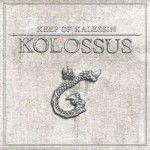 Keep of Kalessin arouse my interest during their demo days, as 1997′s “Skygger av Sorg” repeated the style of old Satyricon in a series of simple, emotional song fragments that revealed a sad beauty lying underneath the grim soundscape. I had heard some less interesting newer material but it is truly shocking what they have submerged into now – an arrogant, over-produced tribute to the honor of Greek warriors through quasi-talented commercial death metal. Synth washes and expressive vocals (in the vein of Nergal when he’s really pissed off in the later Behemoth albums) fill this piece of plastic because they want to sound big and they want to play on a stadium. I am convinced that someone with their musicianship should be able to create a listenable and consistent album, but these super fast blastbeats and commercial heavy metal oriented song dynamics from quiet to loud make this just a faux extreme version of something like Spearhead or Deströyer 666, made worse by the angry shouter vocalist. The people interested only in dry technique and production standards will love this for being an emphatic and empty opera of sharp drumwork and the constantly shifting death metal type fast guitars and entertainment value. They are also happy that it lacks the primal natural force of old Norwegian metal, because it might be distrubing. The sense of space created should be one of a studio or a big venue, instead of a woodland crypt, right? This amount of polishing emphasizes the superficiality of the entire composure, down to metalcore action computer game synchronized by MIDI in Kolossus, where accurate but inconsequential fast drum beats follow cheap-ass tremolo melodies from the pits of norsecore Hell and the vocalist sounds angry at people at the nearby mall and emo pop chorus in “Ascendant” which doesn’t even fit the music underneath. Likewise the arabic solos in the middle part of “Kolossus” don’t seem to have anything to do with the metal riffs, nor do the “300″ soundtrack reminiscent bits with synths and tablas. Whoever has produced this must be a commercial minded jerk.
Keep of Kalessin arouse my interest during their demo days, as 1997′s “Skygger av Sorg” repeated the style of old Satyricon in a series of simple, emotional song fragments that revealed a sad beauty lying underneath the grim soundscape. I had heard some less interesting newer material but it is truly shocking what they have submerged into now – an arrogant, over-produced tribute to the honor of Greek warriors through quasi-talented commercial death metal. Synth washes and expressive vocals (in the vein of Nergal when he’s really pissed off in the later Behemoth albums) fill this piece of plastic because they want to sound big and they want to play on a stadium. I am convinced that someone with their musicianship should be able to create a listenable and consistent album, but these super fast blastbeats and commercial heavy metal oriented song dynamics from quiet to loud make this just a faux extreme version of something like Spearhead or Deströyer 666, made worse by the angry shouter vocalist. The people interested only in dry technique and production standards will love this for being an emphatic and empty opera of sharp drumwork and the constantly shifting death metal type fast guitars and entertainment value. They are also happy that it lacks the primal natural force of old Norwegian metal, because it might be distrubing. The sense of space created should be one of a studio or a big venue, instead of a woodland crypt, right? This amount of polishing emphasizes the superficiality of the entire composure, down to metalcore action computer game synchronized by MIDI in Kolossus, where accurate but inconsequential fast drum beats follow cheap-ass tremolo melodies from the pits of norsecore Hell and the vocalist sounds angry at people at the nearby mall and emo pop chorus in “Ascendant” which doesn’t even fit the music underneath. Likewise the arabic solos in the middle part of “Kolossus” don’t seem to have anything to do with the metal riffs, nor do the “300″ soundtrack reminiscent bits with synths and tablas. Whoever has produced this must be a commercial minded jerk.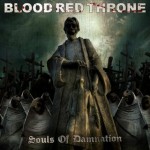 Tchort from Kristiansand was a newcomer to the death metal scene with his band Green Carnation right when the genre went out of fashion because of Euronymous’ hatefulness towards it and while that name was resurrected for Tchort’s progressive metal project he formed the neo-death metal group Blood Red Throne at the end of the millennium. While not having heard the early Green Carnation material, it’s easy to hear from this that some trace of early influence from excellent bands like Grave and Cadaver does exist, but none of their ability to turn basic riff structures into progressive and morbid magic. This type of song construction mostly resembles Cannibal Corpse and Deicide during the latter’s worst days of In Torment In Hell, filling songs with groovy mosh parts, faux-brutal growls and the drummer and bass player (from Deeds of Flesh) insisting wimpily on always playing to the beat of the riff. If this is the king on Norway’s death metal throne since Cadaver disbanded, it is quite sad actually. Most good (death) metal is memorable from its melodies, however convoluted and vicious they may be, but Souls of Damnation is mostly simple rhythmic phrases like guitar exercise patterns for introducing mechanical creation technique for sub-Florida death metal. Like all boring death metal, it severely underestimates its audience. I mean, many listeners do like death metal that sounds like basic no-frills brutal grind, but this worthless chugging goes too far. It seems like the whole album lacks even one interesting melody part or arrangement.
Tchort from Kristiansand was a newcomer to the death metal scene with his band Green Carnation right when the genre went out of fashion because of Euronymous’ hatefulness towards it and while that name was resurrected for Tchort’s progressive metal project he formed the neo-death metal group Blood Red Throne at the end of the millennium. While not having heard the early Green Carnation material, it’s easy to hear from this that some trace of early influence from excellent bands like Grave and Cadaver does exist, but none of their ability to turn basic riff structures into progressive and morbid magic. This type of song construction mostly resembles Cannibal Corpse and Deicide during the latter’s worst days of In Torment In Hell, filling songs with groovy mosh parts, faux-brutal growls and the drummer and bass player (from Deeds of Flesh) insisting wimpily on always playing to the beat of the riff. If this is the king on Norway’s death metal throne since Cadaver disbanded, it is quite sad actually. Most good (death) metal is memorable from its melodies, however convoluted and vicious they may be, but Souls of Damnation is mostly simple rhythmic phrases like guitar exercise patterns for introducing mechanical creation technique for sub-Florida death metal. Like all boring death metal, it severely underestimates its audience. I mean, many listeners do like death metal that sounds like basic no-frills brutal grind, but this worthless chugging goes too far. It seems like the whole album lacks even one interesting melody part or arrangement.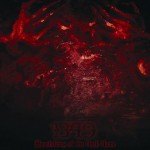 One of the newer Oslo bands mostly known from relentless and uncompromising fast black metal, 1349 surprise with their latest effort in refusing to conform to the rules of the flock. This time conjuring echoes of Samael’s Ceremony of Opposites and later Mayhem, 1349 composes suffocated, devilish and industrial tinged black metal sounds which despite being somewhat predictable, retain the doomy beauty of an industry of inferno. The loneliness of space as described in Moorcock’s trippy novel “The Black Corridor” and the classic fantasy movie “Alien” fill this Gigerian landscape of planets, threats and biomechanical blasphemies. Bodies twitch into contorted positions in a sea of light. The psychedelic feel is enhanced by a cover of Pink Floyd’s “Set the Controls for the Heart of Sun” featuring Tom G. Warrior. Several tracks use minutes to unfold submerged ambient and experimental soundscapes, while there is some Red Harvest type digital manipulation featured in many of the metal songs too. The arrangement is dramatic and regal, with Frost’s drumming skills put to good use. Multiple vocal styles herald the theatrical nature. Some interesting lead guitars add desperate wails to the background. Some parts are in their wicked minimalism close to what one could also expect to, say, Beherit to compose if he were in a more commercial high budget recording project, making this one of the more worthwhile efforts from Norway last year in producing new vistas of black metal.
One of the newer Oslo bands mostly known from relentless and uncompromising fast black metal, 1349 surprise with their latest effort in refusing to conform to the rules of the flock. This time conjuring echoes of Samael’s Ceremony of Opposites and later Mayhem, 1349 composes suffocated, devilish and industrial tinged black metal sounds which despite being somewhat predictable, retain the doomy beauty of an industry of inferno. The loneliness of space as described in Moorcock’s trippy novel “The Black Corridor” and the classic fantasy movie “Alien” fill this Gigerian landscape of planets, threats and biomechanical blasphemies. Bodies twitch into contorted positions in a sea of light. The psychedelic feel is enhanced by a cover of Pink Floyd’s “Set the Controls for the Heart of Sun” featuring Tom G. Warrior. Several tracks use minutes to unfold submerged ambient and experimental soundscapes, while there is some Red Harvest type digital manipulation featured in many of the metal songs too. The arrangement is dramatic and regal, with Frost’s drumming skills put to good use. Multiple vocal styles herald the theatrical nature. Some interesting lead guitars add desperate wails to the background. Some parts are in their wicked minimalism close to what one could also expect to, say, Beherit to compose if he were in a more commercial high budget recording project, making this one of the more worthwhile efforts from Norway last year in producing new vistas of black metal.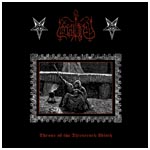 This little EP from Mare, one of the infamous Trondheim cults tends to sound a bit like Live in Leipzig era Mayhem recording in a sewer infested with rats and worms and the decrepit and rotten soundscape makes this one an aesthetically more attractive listen than most of the studio produced turds. Intuitively they grasp the idea of structuring long songs in the old Emperor vein so that while the bits and pieces are redundant, it is a journey through minimalist music themes into the realization and acceptance of the power of darkness. Slow, crawling, anti-logical repetition of simple melody (where the keyboards add a tasteful of old Enslaved) make it a bit of an un-musical experience – the composition seems to be mostly oriented to the fans of droning soundscape whereas the planning and calculation in the overstated reverb, vocal sound (while Kvitrim is good at pacing) and lack of invention in the riffs suggest seem to be aimed for the black metal consumer. But it is deconstructive, degenerate and deceitful music – for pure ideas, about as good as the best of the bunch reviewed here. An ambience and sense of space is reached, the Faustian concept of man as a warrior who travels and explores the universe, only to relinquish his individuality to the higher natural order – in death and rebirth.
This little EP from Mare, one of the infamous Trondheim cults tends to sound a bit like Live in Leipzig era Mayhem recording in a sewer infested with rats and worms and the decrepit and rotten soundscape makes this one an aesthetically more attractive listen than most of the studio produced turds. Intuitively they grasp the idea of structuring long songs in the old Emperor vein so that while the bits and pieces are redundant, it is a journey through minimalist music themes into the realization and acceptance of the power of darkness. Slow, crawling, anti-logical repetition of simple melody (where the keyboards add a tasteful of old Enslaved) make it a bit of an un-musical experience – the composition seems to be mostly oriented to the fans of droning soundscape whereas the planning and calculation in the overstated reverb, vocal sound (while Kvitrim is good at pacing) and lack of invention in the riffs suggest seem to be aimed for the black metal consumer. But it is deconstructive, degenerate and deceitful music – for pure ideas, about as good as the best of the bunch reviewed here. An ambience and sense of space is reached, the Faustian concept of man as a warrior who travels and explores the universe, only to relinquish his individuality to the higher natural order – in death and rebirth.
